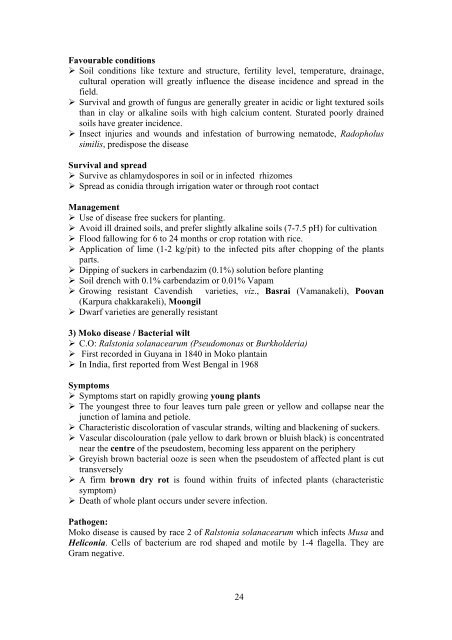PATH 372 Diseases of Horticultural Crops
PATH 372 Diseases of Horticultural Crops
PATH 372 Diseases of Horticultural Crops
You also want an ePaper? Increase the reach of your titles
YUMPU automatically turns print PDFs into web optimized ePapers that Google loves.
Favourable conditions<br />
Soil conditions like texture and structure, fertility level, temperature, drainage,<br />
cultural operation will greatly influence the disease incidence and spread in the<br />
field.<br />
Survival and growth <strong>of</strong> fungus are generally greater in acidic or light textured soils<br />
than in clay or alkaline soils with high calcium content. Sturated poorly drained<br />
soils have greater incidence.<br />
Insect injuries and wounds and infestation <strong>of</strong> burrowing nematode, Radopholus<br />
similis, predispose the disease<br />
Survival and spread<br />
Survive as chlamydospores in soil or in infected rhizomes<br />
Spread as conidia through irrigation water or through root contact<br />
Management<br />
Use <strong>of</strong> disease free suckers for planting.<br />
Avoid ill drained soils, and prefer slightly alkaline soils (7-7.5 pH) for cultivation<br />
Flood fallowing for 6 to 24 months or crop rotation with rice.<br />
Application <strong>of</strong> lime (1-2 kg/pit) to the infected pits after chopping <strong>of</strong> the plants<br />
parts.<br />
Dipping <strong>of</strong> suckers in carbendazim (0.1%) solution before planting<br />
Soil drench with 0.1% carbendazim or 0.01% Vapam<br />
Growing resistant Cavendish varieties, viz., Basrai (Vamanakeli), Poovan<br />
(Karpura chakkarakeli), Moongil<br />
Dwarf varieties are generally resistant<br />
3) Moko disease / Bacterial wilt<br />
C.O: Ralstonia solanacearum (Pseudomonas or Burkholderia)<br />
First recorded in Guyana in 1840 in Moko plantain<br />
In India, first reported from West Bengal in 1968<br />
Symptoms<br />
Symptoms start on rapidly growing young plants<br />
The youngest three to four leaves turn pale green or yellow and collapse near the<br />
junction <strong>of</strong> lamina and petiole.<br />
Characteristic discoloration <strong>of</strong> vascular strands, wilting and blackening <strong>of</strong> suckers.<br />
Vascular discolouration (pale yellow to dark brown or bluish black) is concentrated<br />
near the centre <strong>of</strong> the pseudostem, becoming less apparent on the periphery<br />
Greyish brown bacterial ooze is seen when the pseudostem <strong>of</strong> affected plant is cut<br />
transversely<br />
A firm brown dry rot is found within fruits <strong>of</strong> infected plants (characteristic<br />
symptom)<br />
Death <strong>of</strong> whole plant occurs under severe infection.<br />
Pathogen:<br />
Moko disease is caused by race 2 <strong>of</strong> Ralstonia solanacearum which infects Musa and<br />
Heliconia. Cells <strong>of</strong> bacterium are rod shaped and motile by 1-4 flagella. They are<br />
Gram negative.<br />
24

















